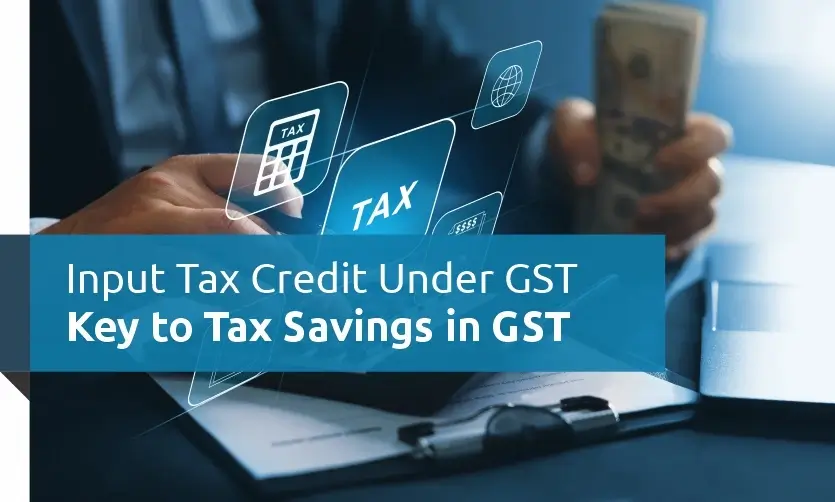
Input Tax Credit Under GST: Key to Tax Savings in GST
The Goods and Services Tax (GST) has revolutionized India’s indirect tax system. One of its key features is the Input Tax Credit (ITC) mechanism, which has simplified the taxation process and reduced the tax burden on businesses. ITC allows registered taxpayers to offset the GST they pay on inputs against the GST they collect on outputs, thereby reducing their overall tax liability.
In this comprehensive guide, we will explore the intricacies of Input Tax Credit under GST, including its importance, eligibility, conditions, and the procedure for claiming it.
Table of Contents
What is an Input Tax Credit under GST?
Input Tax Credit (ITC) is a key feature of the GST regime that allows businesses to offset the GST they pay on their purchases against the GST they collect on their sales.
This prevents the cascading effect of taxes, which means that businesses are not taxed on taxes. This can help to reduce the overall cost of goods and services for consumers, and it can also make businesses more competitive in the global marketplace.
Here is a simple example of how ITC works:
A business buys raw materials for Rs. 10,000, on which they pay 18% GST, or Rs. 1,800. The business then sells finished goods made from the raw materials for Rs. 20,000, on which they collect 18% GST, or Rs. 3,600.
When the business files their GST return, they can claim ITC for the Rs. 1,800 they paid in GST on the raw materials. This reduces their overall tax liability to Rs. 3,600 – Rs. 1,800 = Rs. 1,800.
ITC is a valuable tool for businesses of all sizes. It can help to improve cash flow, reduce costs, and make businesses more competitive.
Types of Taxes Eligible for Input Tax Credit Under GST
The three main types of taxes that are eligible for claiming Input Tax Credit under GST are:
- Central Goods and Services Tax (CGST): This is the central component of the GST, which is levied by the Central Government.
- State Goods and Services Tax (SGST): This is the state-level component of the GST, which is levied by the respective state governments.
- Integrated Goods and Services Tax (IGST): This is applicable for inter-state transactions and is levied by the Central Government, but distributed to the destination state.
Here is an example:
A business in Delhi purchases raw materials from a supplier in Gujarat. The business pays 18% IGST on the purchase. When the business sells finished goods made from raw materials, it collects 18% GST from its customers.
When the business files their GST return, they can claim ITC for the 18% IGST they paid on the purchase of raw materials. This reduces their overall tax liability to zero.
ITC is a valuable tool for businesses of all sizes. It can help to improve cash flow, reduce costs, and make businesses more competitive.
Conditions for Availing Input Tax Credit in GST
To claim Input Tax Credit ( under GST, businesses must meet the following conditions ):
- Valid GSTIN: The supplier and the recipient must have a valid GST Identification Number (GSTIN).
- Receipt of goods or services: The recipient must have received the goods or services.
- Tax invoice: The recipient must have a valid tax invoice or debit note issued by the supplier.
- Payment of tax: The supplier must have paid the GST to the government.
- Filing of GST returns: Both the supplier and the recipient must have filed their respective GST returns.
- Filing within the due date: The recipient must ensure that the supplier has filed their GST return for the respective tax period by the due date.
- Supplier compliance: The supplier must have included the details of the transaction in their GST return.
- Reconciliation: The recipient must reconcile their purchases with the details available in the GST portal.
- Blocked credits: ITC is not available for certain inputs, such as motor vehicles, food and beverages, and health services, unless they are used directly in the business.
In simpler terms, businesses can only claim ITC in GST for goods and services that they have received and paid GST on, and for which the supplier has filed their GST return. The recipient must also reconcile their purchases with the details available in the GST portal.
Importance of Input Tax Credit under GST
Input Tax Credit (ITC) is one of the most important features of the GST regime. Here are some of the key benefits for businesses:
- Reduced tax liability: ITC allows businesses to offset the GST they pay on their inputs against the GST they collect on their outputs. This helps to reduce their overall tax liability and prevent double taxation.
- Competitive pricing: With ITC, businesses can pass on the savings to their customers by offering more competitive prices.
- Improved cash flow: ITC helps businesses improve their cash flow by allowing them to use the credit to offset their tax liability.
- Better compliance: To claim ITC, businesses need to ensure that their suppliers are also compliant with GST regulations. This creates an incentive for businesses to deal with registered and compliant suppliers.
- Transparent system: ITC promotes transparency in the tax system as all transactions are recorded and reported electronically through the GST portal.
GST HSN Codes List: Find the Right Code for Your Products
GST Return Types: Due Dates and Filing Procedures
Types of GST in India: IGST, SGST, CGST & UTGST Made Easy for Students
Here is an example:
A business buys raw materials for Rs. 10,000, on which they pay 18% GST, or Rs. 1,800. The business then sells finished goods made from the raw materials for Rs. 20,000, on which they collect 18% GST, or Rs. 3,600.
When the business files their GST return, they can claim ITC for the Rs. 1,800 they paid in GST on the raw materials. This reduces their overall tax liability to Rs. 3,600 – Rs. 1,800 = Rs. 1,800.
In this example, the business has saved Rs. 1,800 in taxes on their sale of finished goods. This is the power of ITC.
Procedure for Claiming Input Tax Credit Under GST
Claiming Input Tax Credit under GST is a step-by-step process:
- Obtain a valid tax invoice or debit note from your supplier. The invoice should contain all the necessary details, such as the supplier’s GSTIN, a unique invoice number, a date, and a description of the goods or services.
- Verify that your supplier has filed their GST returns and paid the tax due on the supplies made to you. You can do this by checking the GST portal.
- File your GST return accurately and include the details of your purchases. The ITC claim should be reported in your return.
- Reconcile your purchase records with the details available on the GST portal regularly to ensure accuracy.
- While filing your GST return, claim the ITC by mentioning the amount in the appropriate column. This amount will be credited to your electronic credit ledger.
- You can utilize the ITC available in your electronic credit ledger to pay off your tax liability on outward supplies. It can be used for CGST, SGST, or IGST, depending on the nature of the transaction.
- Ensure that you comply with all the due dates for filing GST returns and claiming ITC. Timely compliance is crucial to avoid any penalties or interest.
If you want to learn GST then check out the courses here
Want to become a GST Practitioner?Be confident! Learn GST from Industry Experts |
|
| Browse Classroom Course | Browse Online Course |
| More Learning Options for you: GST Certification Course | TallyPrime with GST and TDS | GST & TDS |
|
Who is not eligible for ITC(Input Tax Credit) under GST?
Input Tax Credit (ITC) is a valuable mechanism for businesses, but there are some exceptions and blocked credits in GST. Here are a few examples:
- Motor vehicles: ITC is not available for motor vehicles and other conveyances unless they are used for specific purposes such as transporting goods, providing taxable services, or resale.
- Food and beverages: ITC on food and beverages, outdoor catering, and related services are blocked unless they are used to provide outward taxable supplies.
- Health services: ITC on health services, cosmetic and plastic surgery, etc., is not available unless it is mandated by the government.
In other words, businesses cannot claim ITC in GST on certain goods and services, even if they are used for business purposes. This is to prevent businesses from claiming ITC on expenses that are considered to be personal or consumption-related.
Conclusion
Input Tax Credit (ITC) is one of the most important features of the GST regime in India. It promotes transparency, reduces tax liabilities, and encourages businesses to deal with registered and compliant suppliers. However, businesses must carefully follow the conditions and procedures outlined by the GST authorities to claim ITC successfully.
As GST regulations continue to evolve. Businesses need to stay updated and compliant to harness the full potential of ITC and contribute to the growth of the Indian economy.





